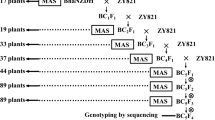Abstract
The recent development of the industrial use of rapeseed oil rich in erucic acid has led to increased interest in the improvement of the high-erucic-acid (50–60%) varieties and to research towards genotypes containing a very high erucic acid content. This trait is controlled by two genes with additive effects. The low-erucic-acid trait was relatively easily introduced through backcrosses into various backgrounds because the zero-erucic-acid homozygotes were clearly identified in the segregating populations. To select for high erucic acid level is more difficult because of the partial overlap of the high-erucic-acid homozygous class and the intermediate one, containing heterozygotes. In order to help conventional breeding, RAPD markers were used to map the two genes involved in determining the erucic acid content in a doubled haploid progeny derived from a ‘low x high’ erucic acid F1 hybrid. The two genes were successfully localized in two independent linkage group, through a QTL approach. A close association was found between individual plant genotypes and the erucic acid content of the doubled haploid progeny, and it was shown that the two genes do not contribute uniformly to the C22:1 level. The value of molecular gene mapping of such a trait in a conventional breeding programme is discussed.
Similar content being viewed by others
Abbreviations
- BSA:
-
bulked segregant analysis
- DH:
-
doubled haploid
- NIL:
-
near-isogenic lines
- QTL:
-
quantitative trait locus
- C22:1:
-
erucic acid
- TAG:
-
triacyl glycerol
- SCAR:
-
sequence characterized amplified region
References
Barua UM, Chalmers KJ, Hackett CA, Thomas WTB, Powell W: Identification of RAPD markers linked to a Rhynchosporium secalis resistance locus in barley using near-isogenic lines and bulked segregant analysis. Heredity 71: 177–184 (1993).
Chen JL, Beversdorf WD: A comparison of traditional and haploid-derived breeding populations of oilseed rape (Brassica napus L.) for fatty acid composition of the seed oil. Euphytica 51: 59–65 (1990).
Downey RK, Harvey BL: Methods of breeding for oil quality in rape. Can J Plant Sci 43: 271–275 (1963).
Doyle JJ, Doyle JL: Isolation of plant DNA from fresh tissues. Focus 12: 13–15 (1990).
Dudley JW: Molecular markers in plant improvement: manipulation of genes affecting quantitative traits. Crop Sci 33: 660–668 (1993).
Foisset N, Delourme R, Lucas MO, Renard M: Segregation analysis of isozyme markers on isolated microsporederived embryos in Brassica napus L. Plant Breed 110: 315–322 (1993).
Haley SD, Afanador L, Kelly JD: Selection for monogenic pest resistance traits with coupling-and repulsionphase RAPD markers. Cell Biol Mol Genet Crop Sci 34: 1061–1066 (1994).
Harvey BL, Downey RK: The inheritance of erucic acid content in rapeseed (Brassica napus L.). Can J Plant Sci 44: 104–111 (1963).
Lander ES, Green P, Abrahamson J, Barlow A, Daly MJ, Lincoln SE, Newburg L: MAPMAKER: an interactive computer package for constructing primary genetic linkage maps of experimental and natural populations. Genomics 1: 174–181 (1987).
Michelmore RW, Paran I, Kesseli RV: Identification of markers linked to disease-resistance genes by bulked segregant analysis: a rapid method to detect markers in specific genomic regions by using segregating populations. Proc Natl Acad Sci 88: 9828–9832 (1991).
Murphy DJ: Modifying oilseed crops for non edible products. Trends Biotechnol 12 (10): 84–87 (1992).
Norton G, Harris JF: Triacylglycerols in oilseed rape during seed development. Phytochemistry 12: 2703–2707 (1983).
Penner GA, Chong J, Lévesque-Lemay M, Monlnar SJ, Fedak G: Identification of a RAPD marker linked to the oat stem rust gene Pg3. Theor Appl Genet 85: 702–705 (1993).
Polsoni L, Kott LS, Beversdorf WD: Large scale microspore culture technique for mutation-selection studies in Brassica napus. Can J Bot 66: 1681–1685 (1988).
Powell W, Thomas WTB, Thompson DM, Swanston JS, Waugh R: Association between rDNA alleles and quantitative traits in doubled haploid populations of barley. Genetics 130: 187–194 (1992).
Reddy AS, Nuccio ML, Gros LM, Thomas TL: Isolation of a Δ6-desaturase gene from the cyanobacterium Synechocystis sp. strain PCC 6803 by gain-of-function expression in Anabaena sp. strain PCC 7120. Plant Mol Biol 27: 293–300 (1993).
Röbbelen G: Trends in plant breeding. Z Pflanzenzücht 94: 499–501 (1979).
Röbbelen G, Thies W: Biosynthesis of seed oil and breeding for improved oil quality of rapeseed. In: Tsunoda S, Hinata K, Gomez-Campo C (eds) Brassica Crops and Wild Allies: Biology and Breeding, pp. 251–283. Japan Scientific Societies Press, Tokyo (1980).
Schuster W: Breeding for desirable fatty-acid composition Swede rape. Z Pflanzenzücht 63: 61–81 (1970).
Siebel J, Pauls KP: Inheritance patterns of erucic acid content in populations of Brassica napus microsporederived spontaneous diploids. Theor Appl Genet 77: 489–494 (1989).
Taylor DC, Weber N: Micropsore-derived embryos of the Brassicaceae-model system for studies of storage lipid bioassembly and its regulation. Fat Sci Technol 96 (6): 228–235 (1994).
Thies W: Schnelle and einfache Analysen der Fettsäurezusammensetzung in einzelnen Rapskotyledonen. I. Gaschromatographische und papier-chromatographische Methoden. Z Pflanzenzücht 65: 181–202 (1971).
Weeden NF, Timmerman GM, Lu J: Identifying and mapping genes of economic significance. Euphytica 73: 191–198 (1994).
Williams JGK, Kubelik AR, Livak KJ, Rafalski JA, Tingey SV: DNA polymorphism amplified by arbitrary primers are useful as genetic markers. Nucl Acids Res 18: 6531–6535 (1990).
Author information
Authors and Affiliations
Rights and permissions
About this article
Cite this article
Jourdren, C., Barret, P., Horvais, R. et al. Identification of RAPD markers linked to the loci controlling erucic acid level in rapeseed. Mol Breeding 2, 61–71 (1996). https://doi.org/10.1007/BF00171352
Received:
Accepted:
Issue Date:
DOI: https://doi.org/10.1007/BF00171352



